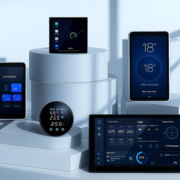Android vs Linux Smart Control Panel
Smart control panels have become central to home automation, industrial automation, and commercial building management. Choosing the right operating system—Android or Linux—can significantly affect performance, compatibility, customization, and long-term reliability. This article explores the differences, advantages, and use cases of Android and Linux smart control panels.
Android Smart Control Panels
Android-based smart control panels are widely used in residential and commercial settings for their intuitive interface, app ecosystem, and fast development cycle.
Advantages:
- User-Friendly Interface – Touchscreen-friendly with colorful GUI and smooth animations.
- App Ecosystem – Supports third-party apps, smart home platforms, and voice assistants like Alexa and Google Assistant.
- Rapid Development – Easy integration with Android SDKs and existing mobile apps.
- Cost-Effective – Components and development resources are widely available.
Ideal Applications:
- Smart home automation (lighting, HVAC, curtains, security)
- Hotels and office automation
- Small to medium commercial buildings
Linux Smart Control Panels
Linux-based smart control panels are often preferred for industrial and large-scale automation projects due to their stability, security, and customization flexibility.
Advantages:
- High Stability – Minimal downtime, ideal for 24/7 industrial operations.
- Customizable & Open Source – Full control over software stack, drivers, and interfaces.
- Protocol Flexibility – Easily integrates with Modbus, KNX, Zigbee, CAN, and other industrial protocols.
- Long-Term Support – Ideal for industrial environments requiring long product lifecycles.
Ideal Applications:
- Industrial automation and factory control
- Large-scale building management systems
- Critical infrastructure monitoring
Key Differences Between Android and Linux Panels
| Feature | Android | Linux |
|---|---|---|
| User Interface | Touchscreen-friendly, app-based | Customizable, functional UI |
| Third-Party Apps | Extensive Google Play ecosystem | Limited, requires custom development |
| Stability | Moderate, consumer-grade | High, industrial-grade |
| Customization | Limited at OS level | Full access, highly flexible |
| Cost | Lower hardware requirements | Higher initial setup but long-term durability |
Choosing the Right Smart Control Panel
- For smart homes and commercial spaces: Android panels are easier to deploy, visually appealing, and support app integrations.
- For industrial, factory, or large-scale automation: Linux panels provide reliability, protocol flexibility, and long-term support.
Portworld offers both Android and Linux smart control panels, ranging from 4-inch to 14-inch displays. Their products support PoE, RS485/RS232, Ethernet, Wi-Fi, and Bluetooth, and they provide OEM/ODM customization for hardware, firmware, and software, allowing integrators to choose the best OS based on project requirements.
The choice between Android and Linux smart control panels depends on the application, user experience needs, and long-term requirements. Android is ideal for interactive, consumer-oriented projects, while Linux excels in industrial and large-scale environments requiring stability and customization. Working with a flexible supplier like Portworld ensures access to both platforms and the ability to tailor solutions for any automation scenario.



